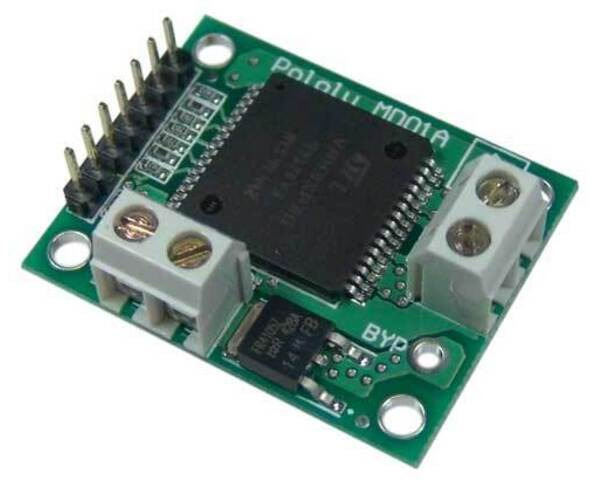30-A motor driver board
| Description | Specs (0) | Pictures (1) | Resources (1) | FAQs (0) | On the blog (0) | Distributors (0) |
|---|
New version available! Please see the new version of the Pololu 30-Amp motor driver board. This page is left up as a reference for customers that have the older version.
The Pololu 30-Amp motor driver board is a compact solution for using the VNH3SP30 motor driver integrated circuit from ST. (The IC is also available by itself) The board incorporates most of the components of the typical application diagram on page 7 of the datasheet, including pull-up and current-limiting resistors and a FET for reverse battery protection. All you need to add is a microcontroller or other control circuit to turn the H-Bridge on and off. If you need a full motor control solution, we also have a high-power motor controller with feedback that uses the same chip.
In a typical application, the motor power supply is connected at the bottom of the board, the motor on the right side of the board, and the control connections to the left side of the board. The diagnostic pins can be left disconnected if you do not want to monitor the fault conditions of the motor driver chip. INA and INB control the direction of the motor, and the PWM pin turns the motor on or off.
Real-world power dissipation considerations
The motor driver has a maximum current rating of 30 A continuous. However, the chip by itself will overheat at much lower currents. The actual current you can deliver will depend on how well you can keep the motor driver cool. In our tests, we were able to deliver short durations (on the order of milliseconds) of 30 A and a few seconds of 20 A without overheating. At 6 A, the chip gets just barely noticeably warm to the touch. For higher currents, a heat sink will be necessary. The motor and power supply wires should also be soldered directly instead of going through the terminal blocks, which are rated for up to 15 A.
Many motor controllers or speed controllers can have peak current ratings that are substantially higher than the continuous current rating; this is not the case with the VNH3SP30, which has a 30 A continuous rating and a over-current protection that can kick in as low as 30 A (45 A typical). Therefore, the stall current of your motor should not be more than 30 A. (Even if you expect to run at a much lower average current, the motor can still draw high currents when it is starting or if you use low duty cycle PWM to keep the average current down.)
Reverse-battery protection
The motor driver board includes an N-channel MOSFET for reverse-battery protection. This component keeps the motor driver from destroying itself if the input power is accidentally connected backwards. However, this component does slightly increase the total resistance between your battery and your motor, and it limits the operating voltage to a maximum of 20 V. For slightly improved performance or for higher-voltage applications, the MOSFET can be bypassed by connecting the negative battery terminal to the bypass pin. (This terminal will also need to be connected to your logic supply ground.)
Note: the 7-pin male header and the two 2-pin terminal blocks are included but not soldered onto the board. No printed documentation is shipped with this item; please see the VNH3SP30 datasheet (586k pdf) for more information about the motor driver chip.





